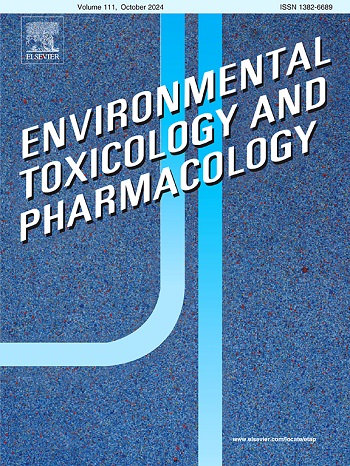Ammonia-induced testicular tissue damage: Apoptosis and autophagy pathways mediated by regulating Cyt C/Bcl-2 and p62/LC3B pathways
IF 4.2
3区 环境科学与生态学
Q2 ENVIRONMENTAL SCIENCES
引用次数: 0
Abstract
Ammonia gas (NH3) is a major hazard in animal husbandry that negatively affects animal growth and reproductive activities. Although the adverse effects of ammonia on livestock health and performance have been studied, its specific effects on the male reproductive system and its underlying biological mechanisms remain unclear. The aim of this study was to investigate the effects of ammonia exposure on male reproduction and its potential mechanisms of action. Immunohistochemistry revealed a significant increase in IL-10 expression in mouse testicular tissues under ammonia-induced stress. Ammonia exposure significantly decreased anti-apoptotic factor Bcl-2 and anti-autophagy factor p62 expression, coupled with increased expression of pro-apoptotic factors, including p53, Caspase-8, Bax, and Apaf, as well as the pro-autophagy factors Beclin1, ATG5, LC3B, the ratio of Bax/Bcl-2 and the ratio of P53/Bcl-2. The fluorescence intensity of the Cyt C apoptotic gene and pro-autophagy factor LC3B in immune tissues was significantly higher than that in the normal control group. In summary, ammonia exposure significantly affects the reproductive ability of male mice by inducing inflammation, apoptosis, and autophagic damage in the testes. Our findings provide insights into ammonia-induced reproductive disorders, which will contribute to the management and control of ammonia in animal husbandry, thereby reducing the negative effects of ammonia on the reproductive health of livestock and poultry and improving the quality and yield of livestock products.
氨诱导睾丸组织损伤:通过调节Cyt C/Bcl-2和p62/LC3B途径介导的凋亡和自噬途径
氨气(NH3)是畜牧业中的主要危害,对动物生长和繁殖活动产生负面影响。虽然已经研究了氨对牲畜健康和生产性能的不利影响,但其对雄性生殖系统的具体影响及其潜在的生物学机制尚不清楚。本研究旨在探讨氨暴露对雄性生殖的影响及其可能的作用机制。免疫组化显示氨诱导应激小鼠睾丸组织中IL-10表达显著升高。氨暴露显著降低抗凋亡因子Bcl-2和抗自噬因子p62的表达,促凋亡因子p53、Caspase-8、Bax、Apaf以及促自噬因子Beclin1、ATG5、LC3B的表达,Bax/Bcl-2比值和p53 /Bcl-2比值升高。免疫组织中Cyt C凋亡基因和促自噬因子LC3B的荧光强度明显高于正常对照组。综上所述,氨暴露通过诱导睾丸炎症、细胞凋亡和自噬损伤显著影响雄性小鼠的生殖能力。本研究为氨致生殖障碍的研究提供了新的思路,为畜牧业氨的管理和控制提供了依据,从而减少氨对畜禽生殖健康的负面影响,提高畜产品的质量和产量。
本文章由计算机程序翻译,如有差异,请以英文原文为准。
求助全文
约1分钟内获得全文
求助全文
来源期刊
CiteScore
7.00
自引率
4.70%
发文量
185
审稿时长
34 days
期刊介绍:
Environmental Toxicology and Pharmacology publishes the results of studies concerning toxic and pharmacological effects of (human and veterinary) drugs and of environmental contaminants in animals and man.
Areas of special interest are: molecular mechanisms of toxicity, biotransformation and toxicokinetics (including toxicokinetic modelling), molecular, biochemical and physiological mechanisms explaining differences in sensitivity between species and individuals, the characterisation of pathophysiological models and mechanisms involved in the development of effects and the identification of biological markers that can be used to study exposure and effects in man and animals.
In addition to full length papers, short communications, full-length reviews and mini-reviews, Environmental Toxicology and Pharmacology will publish in depth assessments of special problem areas. The latter publications may exceed the length of a full length paper three to fourfold. A basic requirement is that the assessments are made under the auspices of international groups of leading experts in the fields concerned. The information examined may either consist of data that were already published, or of new data that were obtained within the framework of collaborative research programmes. Provision is also made for the acceptance of minireviews on (classes of) compounds, toxicities or mechanisms, debating recent advances in rapidly developing fields that fall within the scope of the journal.

 求助内容:
求助内容: 应助结果提醒方式:
应助结果提醒方式:


